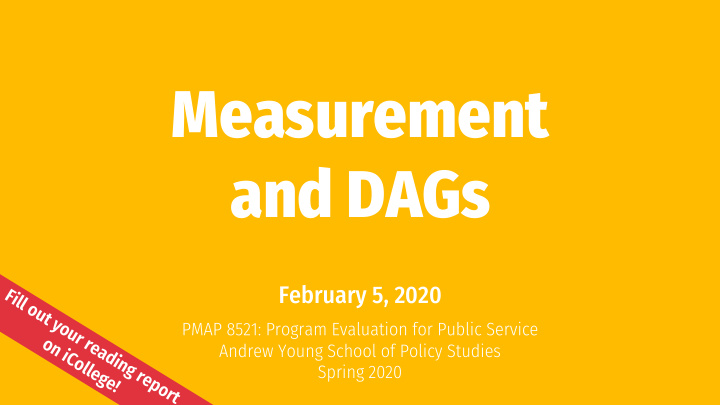



Measurement and DAGs February 5, 2020 Fill out your reading report PMAP 8521: Program Evaluation for Public Service on iCollege! Andrew Young School of Policy Studies Spring 2020
Plan for today Abstraction, stretching, and validity Causal models Equations, paths, doors, and adjustment
Abstraction, stretching, and validity
Indicators Inputs, activities, Outcomes & outputs Harder to directly Generally directly measure measurable Commitment to school, # of citations mailed, reduced risk factors % increase in grades, etc.
Conceptual stretching
Ladder of abstraction for witches Mammal Trolls, elves, Enmagicked gods/goddesses Female Arwen, Winky, Athena Human Old Elphaba Young Salem witch trials Halloween Student Hermione Granger decorations Sabrina Spellman
Connection to theory
Practice Choose an outcome List all the possible attributes of that outcome Build a ladder of abstraction with all the attributes Determine which level is sufficient for showing an effect Juvenile delinquency School performance Poverty
Outcomes and programs Outcome variable Thing you’re measuring Outcome change ∆ in thing you’re measuring over time Program effect ∆ in thing you’re measuring over time because of the program
Outcomes and programs Outcome with program Post-program outcome level Outcome variable Program effect Outcome change Outcome without program Pre-program outcome level Before program During program After program
Connecting measurement to programs Measurable definition of program effect Ideal measurement Feasible measurement Connection to real world Juvenile delinquency School performance Poverty
Causal models
Types of data Observational Experimental You have control over You don’t have control over which units get treatment which units get treatment Which kind lets you prove causation?
Causation with observational data Can you prove causation with observational data? Why is it so controversial to use observational data?
The causal revolution
Causal diagrams Directed acyclic graphs (DAGs) Graphical model of the process that generates the data Maps your philosophical model Fancy math (“do-calculus”) tells you what to control for to find causation
DAGs Directed acyclic graphs encode our understanding of the causal model (or philosophy) ● ● Y ● ● X
What is the causal effect of an additional year of education on earnings? Step 1: List variables Step 2: Simplify Step 3: Connect arrows Step 4: Use logic and math to determine which nodes and arrows to measure
1. List variables Earnings (outcome) Education (treatment) List anything that’s relevant Things that cause or are caused by treatment, especially if they’re related to both treatment and outcome You don’t have to actually observe or measure them all
1. List variables Earnings (outcome) Education (treatment) Location Ability Demographics Socioeconomic status Year of birth Compulsory schooling laws Job connections
2. Simplify Earnings (outcome) Education (treatment) Location Ability Demographics Socioeconomic status Year of birth Compulsory schooling laws Job connections Background
3. Draw arrows Earn Education causes earnings Edu
3. Draw arrows Background, year of birth, location, school requirements Loc all cause education Year Earn Edu Req Bkgd
3. Draw arrows Loc Req Edu JobCx Earn Background, year of birth, and location all effect earnings too Year Bkgd
3. Draw arrows Loc Req Year Edu Job connections are Earn caused by education JobCx Bkgd
3. Draw arrows Year JobCx Earn Edu Req Bkgd Location and background are probably Loc related, but neither causes the other. Something unobservable does that (U1) U1
Let the computer do this! Year JobCx dagitty.net Earn Edu Req Bkgd Loc U1
Your turn Does a longer night’s sleep extend your lifespan? Step 1: List variables Step 2: Simplify Step 3: Connect arrows Use dagitty.net
Equations, paths, doors, and adjustment
Causal identification All these nodes Year are related; JobCx there’s correlation between them all Earn Edu We care about Req Bkgd Edu → Earn, but what do we do with Loc all the other nodes? U1
Causal identification A causal effect is “identified” if the association between treatment and outcome is properly stripped and isolated
Paths and associations Arrows in a DAG transmit associations You can redirect and control those paths by “adjusting” or “conditioning”
Three types of associations Confounding Causation Collision Common cause Mediation Selection / Endogeneity
Confounding X causes Y But Z causes both X and Y Z confounds X → Y association
Paths Paths between X and Y? X → Y X ← Z → Y Z is a backdoor
Backdoor! Paths between money and win margin? Money → Margin Money ← Quality → Margin
Closing doors Close the backdoor by adjusting for Z
Find what part of X (campaign money) is explained by Q (quality), subtract it out. This creates the residual part of X. Find what part of Y (the win margin) is explained by Q (quality), subtract it out. This creates the residual part of Y. Find relationship between residual part of X and residual part of Y. This is the causal effect.
We’re comparing candidates as if they had the same quality We remove differences that are predicted by quality Holding quality constant
<latexit sha1_base64="o5HLXxGhe/M81/uQ/f19Qtjo=">ACUnicbVJNixNBEO1k3Q/j7prVo5fGIAhCmImCXoTFXDxGMB+QhFDTU8kW290zdtcshiG/cUG87A/x4kHtJEPQrAUNj/deUdWvO8k1eY6iu1r94MHh0fHJw8aj07Pzx82LJwOfFU5hX2U6c6MEPGqy2GdijaPcIZhE4zC57q714Q06T5n9zMscpwYWluakgAM1a9KE8SuXQ7LSgFuQXcn3cpIgwySryoUy62rCyYHWgRrZnG52umdnW5TSoFRfilAE28tmHvS61mtqB1tSt4HcQVaoqrerPltkmaqMGhZafB+HEc5T0twTErjqjEpPOagrmGB4wAtGPTchPJSr4ITCrnmQvHstywf3eUYLxfmiQ4DfCV39fW5P+0cHzd9OSbF4wWrUdNC+05Eyu85UpOVSslwGAchR2leoKHCgOr9AIcT7V74PBp12/Lrd+fSmdfmhiuNEPBPxUsRi7fiUnwUPdEXStyKH+KX+F37XvtZD79ka63Xqp6n4p+qn/4B9Rez3Q=</latexit> <latexit sha1_base64="bak5KZt7lcpKt0gTEobmPDf1LJ4=">ACUnicbVJBaxNBFJ7Eqm1aNeqxl6GhIAhty3oRSj24rGCaQrZUN7OvmwenZmdzrwVw5LfKIgXf4gXD+pskNtfTDw8X3f4735ZnKnKXCS/Oh0H2w9fPR4e6e3u/fk6bP+8xcXoaq9wpGqdOUvcwioyeKIiTVeOo9gco3j/Pqs1cef0Qeq7CdeOJwaKC3NSAFH6qpPGeMXbsZkpQFfkl3KdzID7eYgX8sRwaZybXpDIwDKqOzsrhYtnoJxtw2IKYJQ3NWjitQdIN3OGiTDZFXyPkg3YCA2dX7V/5YVlaoNWlYaQpikieNpA5JaVz2sjqgA3UNJU4itGAwTJtVJEt5GJlCziofj2W5Ym93NGBCWJg8Og3wPNzVWvJ/2qTm2dtpQ9bVjFatB81qLbmSb6yI+K9SICUJ7irlLNwYPi+Aq9GEJ698r3wcXRMD0eHn08GZy+38SxLfbFgXglUvFGnIoP4lyMhBJfxU/xW/zpfO/86sZfsrZ2O5uel+Kf6u79BSRQs/Y=</latexit> How to adjust? Include term in regression Win margin = � 0 + � 1 Campaign money + � 2 Candidate quality + ✏ Win margin = ↵ + � Campaign money + � Candidate quality + ✏ Matching Do-calculus Inverse probability weighting
Recommend
More recommend